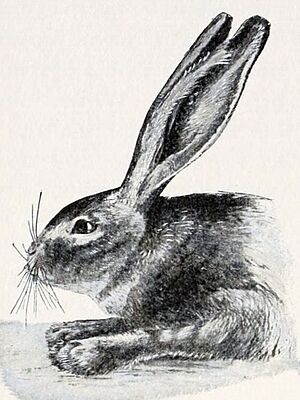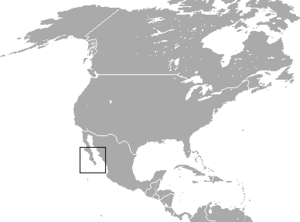Black jackrabbit facts for kids
Quick facts for kids Black jackrabbit |
|
|---|---|
 |
|
| Conservation status | |
| Scientific classification | |
| Genus: |
Lepus
|
| Species: |
insularis
|
 |
|
| Range of the black jackrabbit | |
The black jackrabbit (Lepus insularis) is a special type of mammal that belongs to the rabbit and hare family, Leporidae. This animal is found only in one place in the world: Espiritu Santo Island in the Gulf of California, off the coast of Mexico. Because it lives in such a small area, the IUCN (International Union for Conservation of Nature) has listed it as a "vulnerable species". Some scientists think it might be a type of black-tailed jackrabbit, which lives on the mainland of Mexico.
Contents
What Does the Black Jackrabbit Look Like?
The black jackrabbit is a medium-sized animal. It grows to be about 55 cm (22 in) long, including its tail, which is about 9.5 cm (4 in) long.
Its most noticeable feature is its fur! The top of its head, back, and the top of its tail are a shiny black color, sometimes with a brownish tint. The sides of its body, head, and legs are a darker brown or buffy-brown. Its belly and the underside of its tail are usually a lighter brown. Around its eyes, you'll see a ring of grey fur. The inside of its ears are greyish-black and have long, grey hairs.
Where Do Black Jackrabbits Live?
The black jackrabbit lives only on Espiritu Santo Island, which is located near Baja California in Mexico. This island is its only home!
You can find these jackrabbits in many different parts of the island. They like grassy and rocky hillsides, flat areas called plateaus, sandy dunes, and the bottoms of valleys. They often live on bare slopes and among different plants like grasses, herbs, shrubs, and cacti.
Island Life and Other Animals
The black jackrabbit's black fur makes it stand out against the brown, grey, and green colors of its island home. Its close relative, the black-tailed jackrabbit on the mainland, is not black. This is because the mainland jackrabbits have many predators (animals that hunt them), so being black would make them too easy to spot. On Espiritu Santo Island, there are no large predators that hunt the jackrabbits.
The black jackrabbit shares its island home with several other interesting animals. These include the Espíritu Santo antelope squirrel, the spiny pocket mouse, the cactus mouse, the desert woodrat, and the ring-tailed cat. You can also find different kinds of lizards and snakes on the island. Two types of birds that hunt are also present: the crested caracara and the American kestrel.
Protecting the Black Jackrabbit
The black jackrabbit lives only on Espiritu Santo Island. This means its entire home covers an area of just 95 km2 (37 sq mi). Even though it's common across much of the island and its numbers seem steady, its small home makes it vulnerable.
The main dangers to the black jackrabbit are new animals being brought to the island that don't belong there, and human activities that disturb its habitat. Because of these threats, the IUCN has listed its conservation status as "near threatened."
Luckily, the island is not inhabited by people. The Mexican government protects Espiritu Santo Island as part of the Área de Protección de Flora y Fauna: Islas del Golfo de California. This means the plants and animals there are safe. The island is also a popular place for ecotourism, where people visit to enjoy nature responsibly. In 1995, UNESCO declared it part of a Biosphere Reserve, called Islas del Golfo de California, which helps protect its unique environment even more.
Images for kids


